 "Chan - Mid-engine with cabin fever" (superchan7)
"Chan - Mid-engine with cabin fever" (superchan7)
12/03/2015 at 02:20 ē Filed to: Ferrari, F355, 355, 355F1, maintenance, major service, engine out
 58
58
 77
77
 "Chan - Mid-engine with cabin fever" (superchan7)
"Chan - Mid-engine with cabin fever" (superchan7)
12/03/2015 at 02:20 ē Filed to: Ferrari, F355, 355, 355F1, maintenance, major service, engine out |  58 58
|  77 77 |
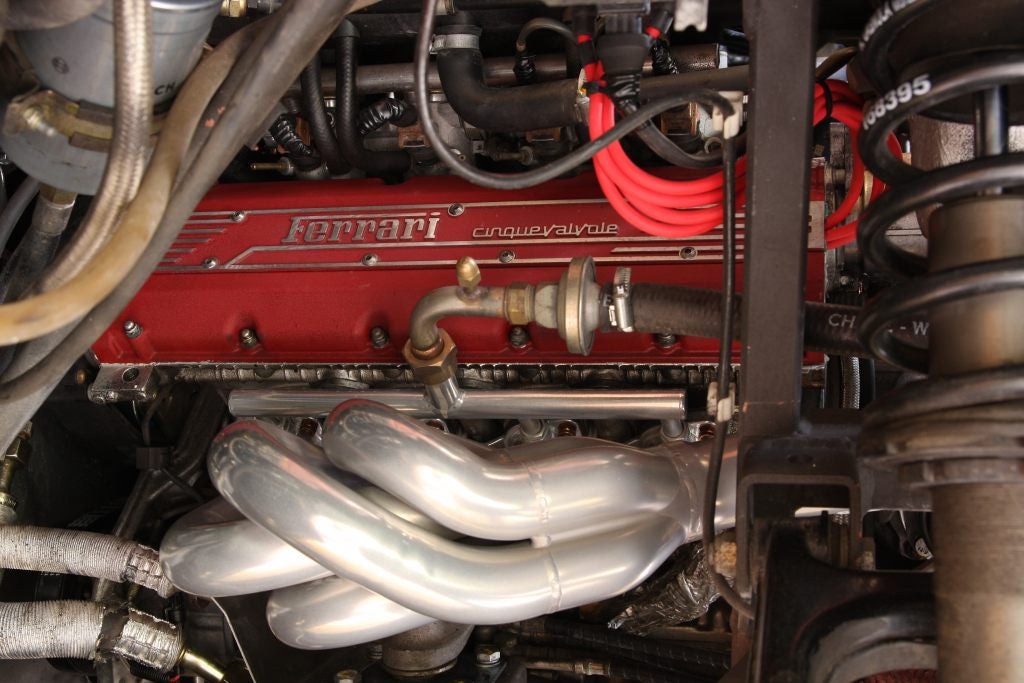
Hi, Iím still new here, so before I get to more current activities, I thought I would go back to some significant car-related adventures in the recent past.
Here is the F355 engine-out service of Internet infamy. This was done exactly a year ago (2014). Most of the pics were taken by the mechanic, so credit goes to him and if he sees this I hope he doesnít mind me sharing. I have cropped the pics in funny ways to protect his privacy; please forgive me.
Through documenting this service Iíve learned way too many things to fully share here. So if anyone is interested in pursuing ownership of an F355, I can answer most questions about maintenance. I do know a few things about other Ferrari models as well.
!!! UNKNOWN CONTENT TYPE !!!
To start, the rear bumper and rear wheels are removed. The famous Tubi exhaust is shown in all its glory.
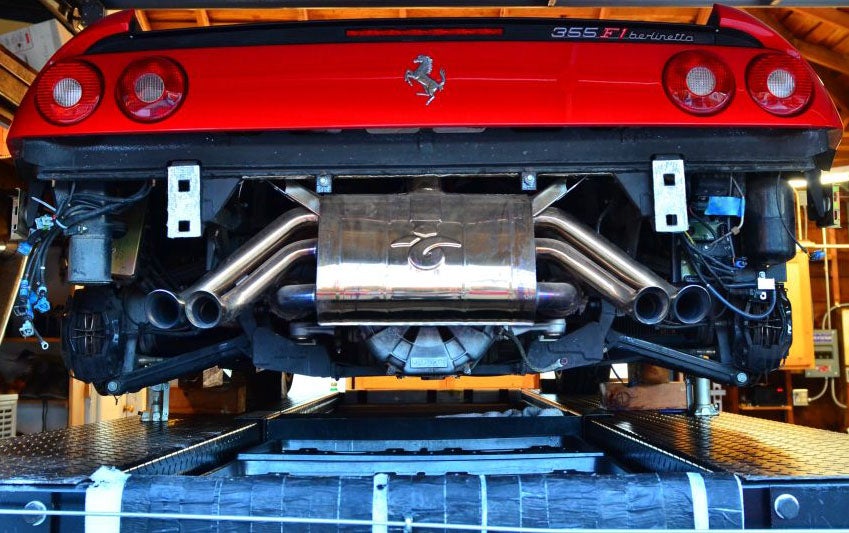
!!! UNKNOWN CONTENT TYPE !!!
All fluids are drained. All of the electrical harness lines, fuel lines, coolant lines, hydraulic brake and steering lines, transmission control lines (there is no shift rod in an F1 car), etc. are disconnected from the engine and covered with protective wrap. Then the entire rear subframe is unbolted from the unibody and lowered onto a dolly. This includes the engine, exhaust and rear suspension.
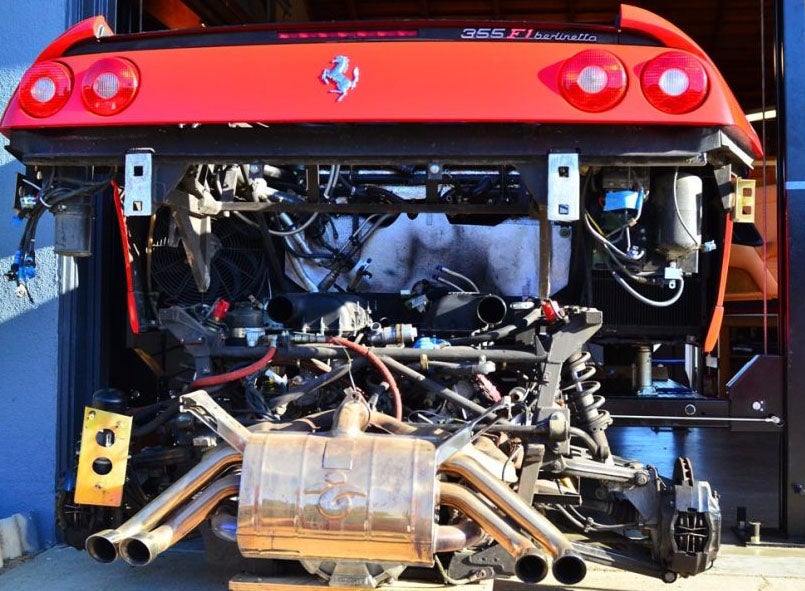
The rear subframe can now be carted away from the car, leaving a big gaping hole where the ďrear end of the FerrariĒ used to be. The rear bodywork and the two radiators remain with the car.
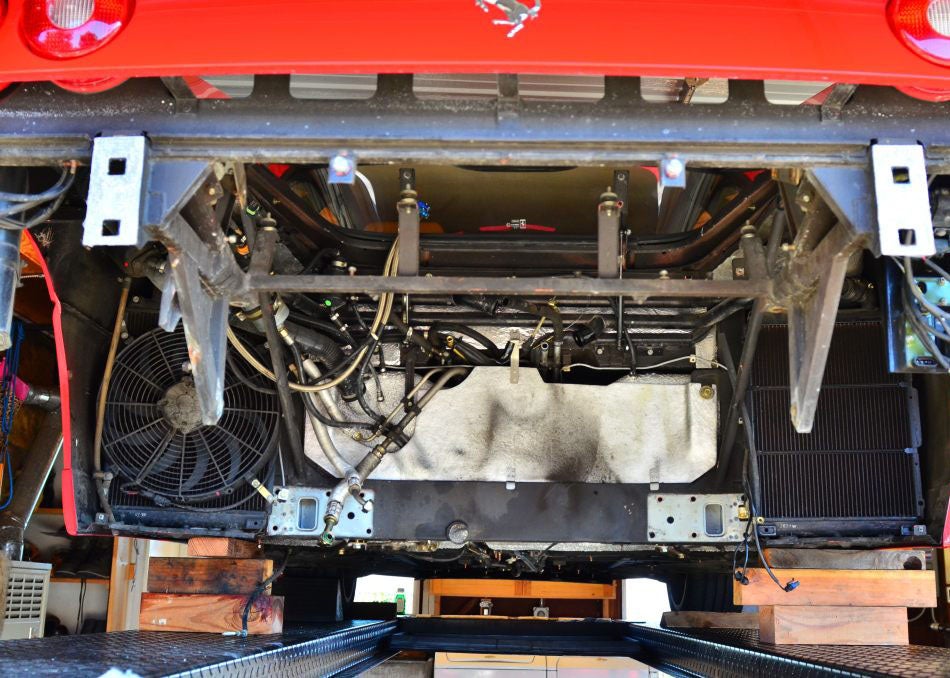
!!! UNKNOWN CONTENT TYPE !!!
The engine now sits on a dolly, ready for the maintenance work. The main reason for removing the engine is to access the forward side belts, which normally face the firewall and fuel tank. Also on the forward side are the water pump, alternator, A/C compressor and power steering pump. Here, the cam timing belts are still hidden behind plastic shrouds. Visible are the alternator belt, A/C compressor belt and the power steering pump belt.
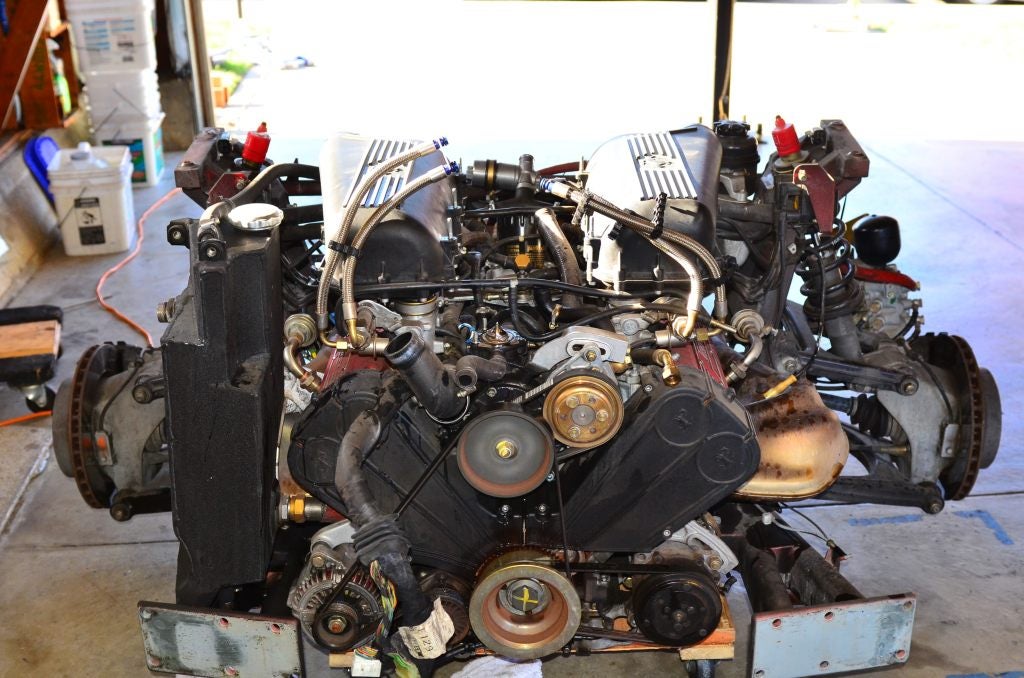
Also visible is the giant dry-sump oil tank standing beside the engine. It smells of man points. So, removing those belts and the plastic shrouds reveals the two timing belts.
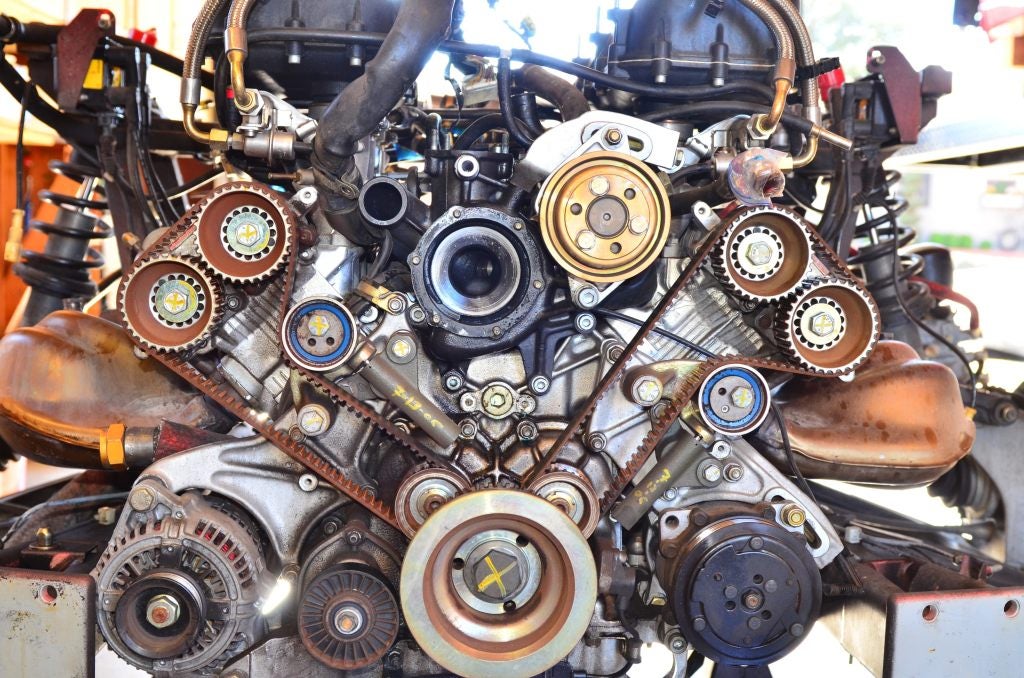
!!! UNKNOWN CONTENT TYPE !!!
This is as far down in detail as I will go with pictures, as everything else about the belt change is conceptually identical to any other modern car. Many owners call this the ďbelt service,Ē in the name of the primary items being replaced, but there is much more to it. The cam timing is checked by aligning the engineís ďTDCĒ (top dead centre) position with a degree wheel.
Here are some of the other things that were also replaced:
Valve/cam cover gasket: Standard major service item, included in the basic 5-year service kit.
Cam seals: Qty 4, included in the service kit.
Fuel filter: Included in the service kit.
Air filters: Qty 2, included in the service kit.
Belt tensioner bearings: Aftermarket (Hill Engineering) design is more durable.
Water pump: The OEM pump is not very durable and was preemptively rebuilt with a widely available kit.
Spark plugs, plug gaskets and wires: the plugs are common and cheap NGK. The wires arenít, and the infernal heat corrodes wires quickly.
Several coolant hoses that cracked. Some are cheap and easy to source. Some are horrifyingly expensive due to limited availability. A custom fabricator would be a good friend to have if you canít find a hose with a reasonable price.
Coolant temperature sensors: The carís immense heat often leads to early failure. These were preemptively replaced. Two of the three are affordable. The third one is over $200.
Exhaust O2 sensors: These were also preemptively replaced as they tend to fail and throw error lights (Ferrariís infamous ďSlow DownĒ light). 1995 cars are OBD1 and only have pre-cat sensors. 1996+ cars are OBD2-compliant and have pre- and post-cat sensors. This car is the latter.
Engine mounts: The engine was visibly sagging on the subframe. The two forward engine mounts were replaced with more robust units from the F355 Challenge race car, also shared with the 550 Maranelloís heavier V12.
CV joint boots: These were cracked from heat stress, despite a hefty fibreglass heat shield surrounding them. They are assumed to be needed for every major service. Both the wheel side and gearbox side boots are replaced. The kit isnít too expensive, but it is convenient to replace while the subframe is out.
All fluids are replaced here, and also replaced annually. I do mean all fluids, including power steering. F1 cars are unique in that they use
both
MT gear oil and ATF, the latter being for the hydraulic actuators of the F1 shifter and clutch.
Engine bonnet and front lid struts.
!!! UNKNOWN CONTENT TYPE !!!
Now, the headline news on this particular car is a problem known to all F355s: the right side exhaust header has cracked open, producing fragments that damaged the catalytic converter.
The first symptom is the broken catalyst cell pieces banging around in the cat shell:
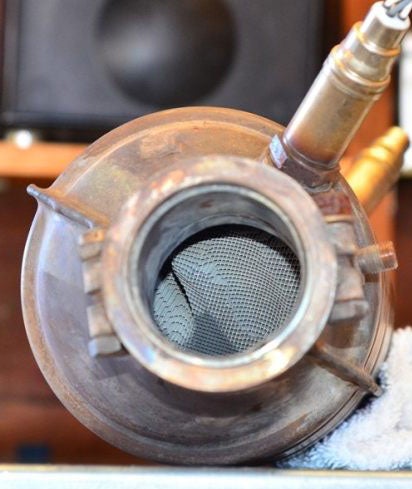
When the RHS header is shaken, stuff falls out. Thatís not good. So, we all want to see what a failed steel manifold looks like, right? Alright, the headerís steel heat shield is cut open, showing the following gruesome scene:
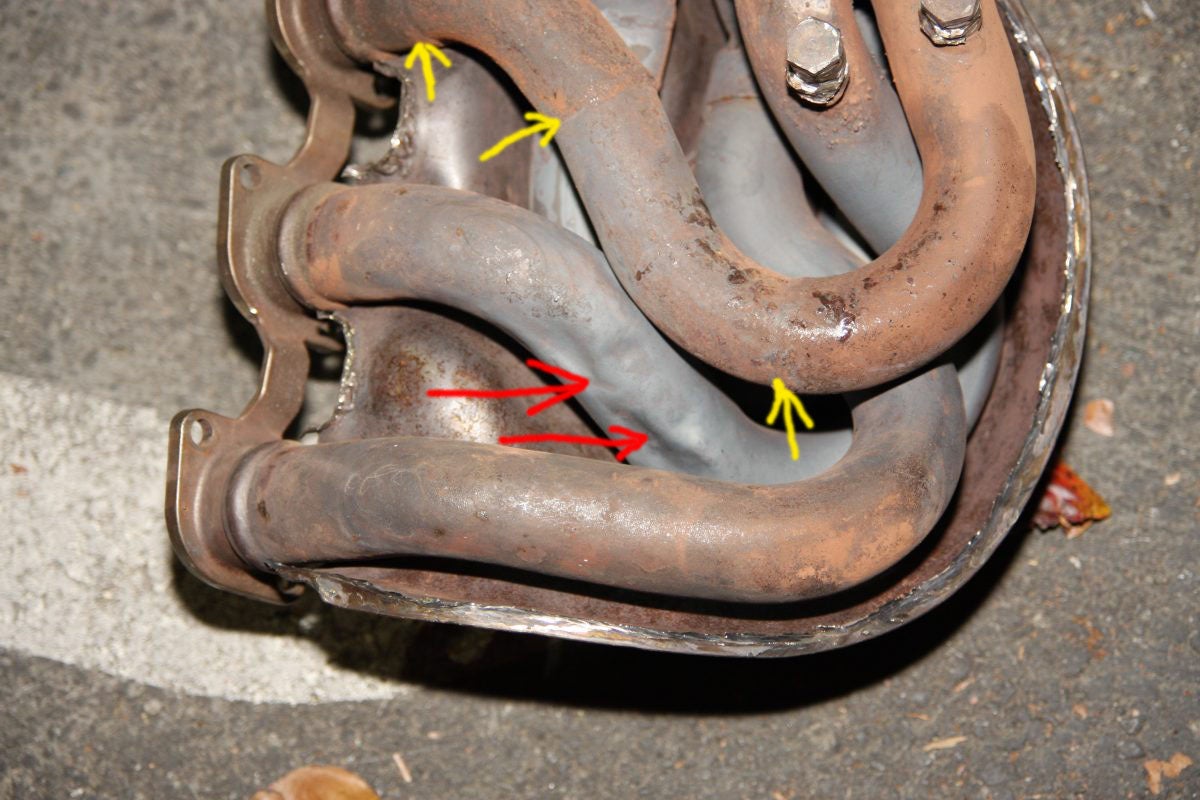
The red arrows point to obvious places where the steel is deforming and the tube is collapsing from the exhaust pulses and extreme heat. Ferrari had famously used T409 mild steel, which was insufficient.
The yellow arrows point to places where the header had previously leaked and been repaired. Pipe sections from another car were welded in. Not sure how cost-effective this was in lieu of replacing the entire manifold.
!!! UNKNOWN CONTENT TYPE !!!
So the headers and cats are both unusable.
New headers are ordered from Fabspeed. They are exposed tubes with no external heat shield, so Fabspeed offers a ceramic coating service at extra cost. A tough, dull coating is applied to the inside to resist high exhaust temperature. A light, decorative and protective coating is applied to the outside to protect against corrosion. As many know, Fabspeed uses T304 steel which is much more heat-resistant than the T409.
There are now several different options for header replacement, but Fabspeed and Tubi are the only makers of completely new units. If you are at all curious, I chose Fabspeed mainly because they are a relatively large US-based company with a good reputation for customer service. There is some peace of mind to be had for that.
The headers are mounted on the freshly serviced engine. How can you not like open exhaust manifolds when you see this beauty?
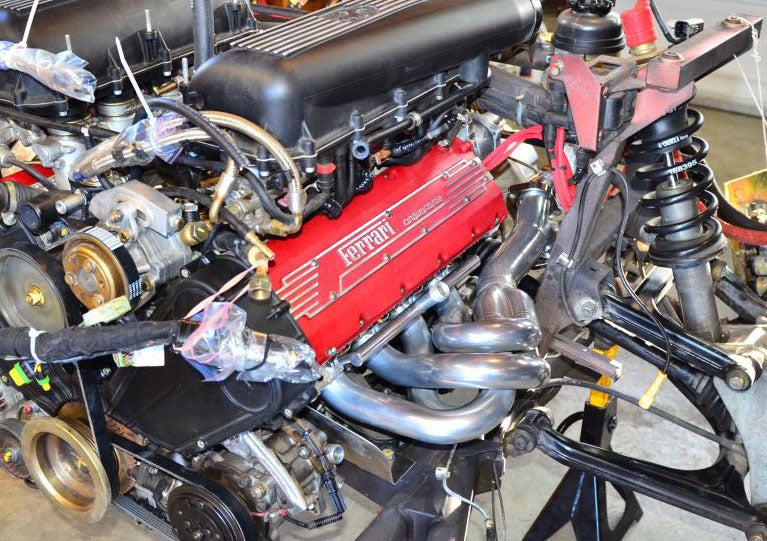
!!! UNKNOWN CONTENT TYPE !!!
The cats were also restored by Fabspeed using the original shells, but with new cells welded in. The new cells are metallic-core (rhodium/palladium/platinum or something like that), unlike the relatively fragile ceramic-core cells used by Ferrari in the 1990s.
Due to deadlines and steadily mounting impatience, shipping upgrades to and from Fabspeed run up hundreds of dollars.
The new headers and cats end up costing $5,000 in parts alone.
!!! UNKNOWN CONTENT TYPE !!!
Another common item is repainting the valve covers. They are red as in most Ferrari engines, and they fade, crack and peel off over time. These guys, however, looked great after a simple wash as you can see in the pictures.
So the engine goes back into the car, everything is connected up again, and we take the car on a test drive.
Less than a week after the car is put back together, it overheats.
Both radiator fans have blown their fuses.
Add 2 radiator fans to the list of parts.
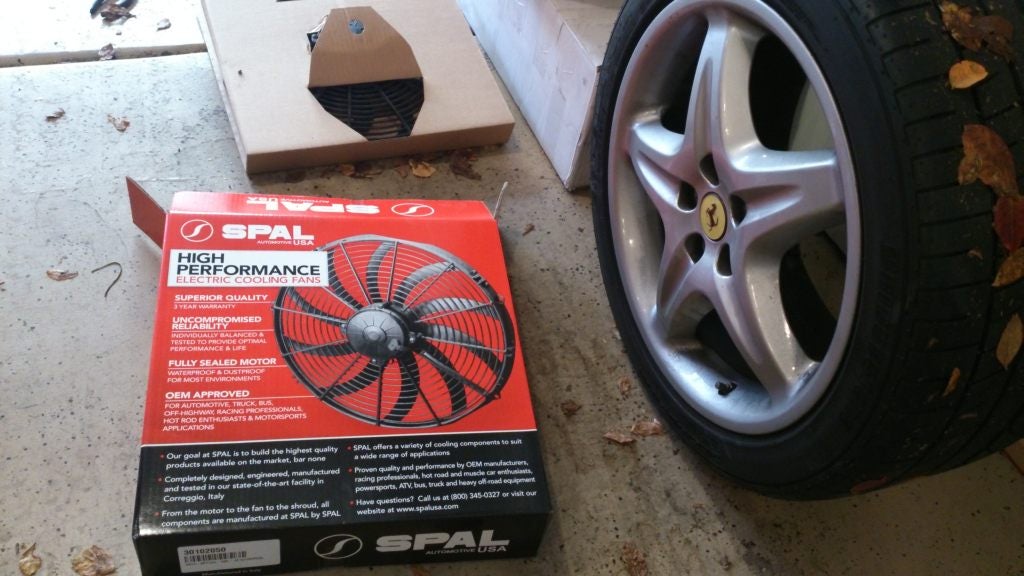
!!! UNKNOWN CONTENT TYPE !!!
The fuse for the right fan had melted, but the fuse for the left side fan has literally exploded in an amazing and slightly terrifying way:
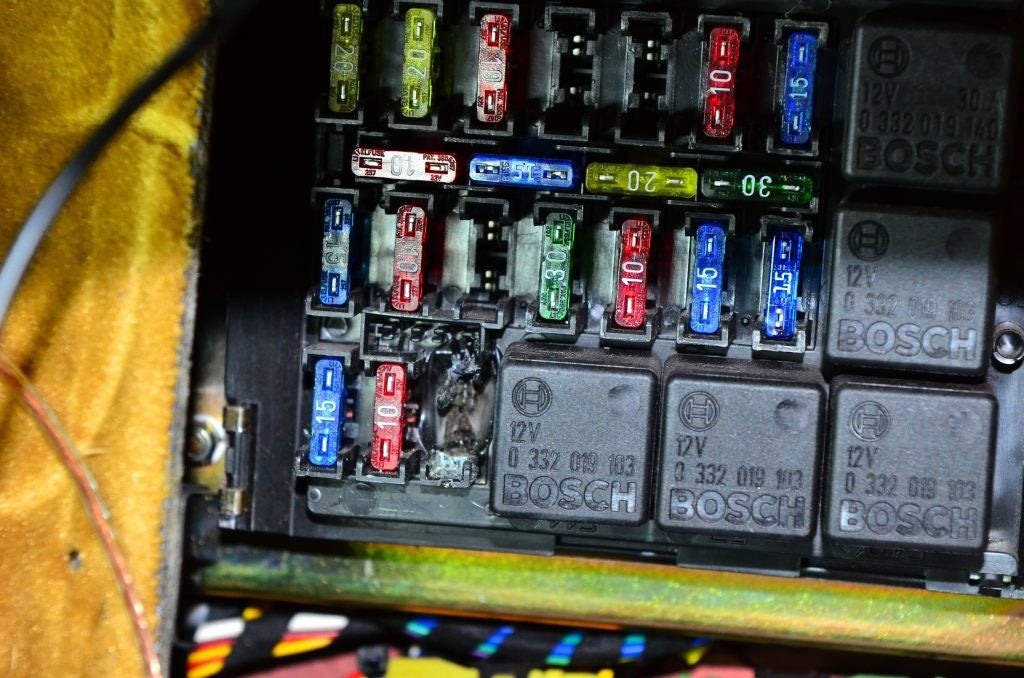
Fortunately, the fuse board was still working.
Ferrari had inexplicably specified open-motor fans for both the F355 Challenge race car and the road car. The motor becomes soiled with dust and eventually draws an excessive electrical load, blowing fuses. Replacing just the fuse is a very, very bad idea. Replacing with a higher-rated fuse will result in your fuse board launching your car into orbit, your car being blacklisted on Ferrari forums, and finally you being ridiculed for 355 years. Vicious forum members will then high-five each other with posts like ď+355Ē.
SPAL, the manufacturer of the fans, cleverly started offering a sealed-motor version of the F355 cooling fans. That, lads, is the one to buy.
!!! UNKNOWN CONTENT TYPE !!!
So there are a lot of lessons here: Firstly, the F355ís maintenance needs are very, very well understood.
Second, aftermarket parts have significantly improved the F355ís reliability and many of these items (headers and cats, Iím looking at you) are theoretically permanent fixes for inferior OEM parts.
Once sorted, the F355 (and yes, even the 355F1) can and does run relatively reliably for many owners. I do feel sorry for the early owners who ate most of the depreciation and the staggering maintenance bills for parts that would eventually break again.
Feel free to let me know if you enjoyed reading, or if you have any questions regarding the major service or other maintenance needs of the F355. Cheers and safe motoring to all!!
Iíve said it before and I will say it again here: Once the car roars (and screams) its way back to life, there is absolutely nothing like an F355 on the road. Not even an MR2.
!!! UNKNOWN CONTENT TYPE !!!
 911e46z06
> Chan - Mid-engine with cabin fever
911e46z06
> Chan - Mid-engine with cabin fever
12/03/2015 at 02:31 |
|
So I saw your earlier 355 post, and I was unaware that one of them was yours. Youíre Oppo royalty, bro. Keep the 355 content cominí!
 Chan - Mid-engine with cabin fever
> 911e46z06
Chan - Mid-engine with cabin fever
> 911e46z06
12/03/2015 at 02:37 |
|
Glad to share! Iím not made of money like most in the Fezza crowd, which is actually why I need to fix it right and not use stop-gap solutions. Because it can come back to bite your @$$ hard!!
Ferrari, where third-party parts improve the carís reliability instead of its performance. Thank goodness for the aftermarket!
 911e46z06
> Chan - Mid-engine with cabin fever
911e46z06
> Chan - Mid-engine with cabin fever
12/03/2015 at 02:41 |
|
Yeah dude. Weíre all envious of you. We all want to buy an old Ferrari, but none of us have the balls.
Itís interesting stuff man. I think I can speak for most of the Oppo crowd in saying weíre interested in knowing what Ferrari ownership is like for a regular dude.
 66671 - 200 [METRIC] my dash
> Chan - Mid-engine with cabin fever
66671 - 200 [METRIC] my dash
> Chan - Mid-engine with cabin fever
12/03/2015 at 02:54 |
|
Awesome post, but man does that look like a pain in the ass lol. Would love to see more from the shop.
 desertdog5051
> Chan - Mid-engine with cabin fever
desertdog5051
> Chan - Mid-engine with cabin fever
12/03/2015 at 03:42 |
|
Great write up. Thanks.
 Chan - Mid-engine with cabin fever
> 66671 - 200 [METRIC] my dash
Chan - Mid-engine with cabin fever
> 66671 - 200 [METRIC] my dash
12/03/2015 at 04:17 |
|
Not only that, but also a pain in the lower back, thighs, calves and fingers.
This is the highlight by far, but other things have also been done to the car. More soon.
 CCC (formerly CyclistCarCoexist)
> Chan - Mid-engine with cabin fever
CCC (formerly CyclistCarCoexist)
> Chan - Mid-engine with cabin fever
12/03/2015 at 04:54 |
|
Ferrari headers from what I hear aren't that great...I think Rob ferretti or Farah had to get headers replaced on a 360, and Ferrari was changing them at least 10k. Ends hiring someone to make a aftermarket header was way more cheaper
 SnapUndersteer, Italian Spiderman
> Chan - Mid-engine with cabin fever
SnapUndersteer, Italian Spiderman
> Chan - Mid-engine with cabin fever
12/03/2015 at 07:55 |
|
ďOnce the car roars (and screams) its way back to life, there is absolutely nothing like an F355 on the road. Not even an MR2.Ē
That sentence can only come from a man who has never driven a Suzuki Every Joy Pop Turbo.
 450X_FTW
> Chan - Mid-engine with cabin fever
450X_FTW
> Chan - Mid-engine with cabin fever
12/03/2015 at 08:25 |
|
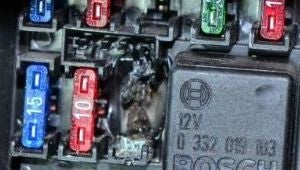
Sees ďreadiator fan blew a fuse, replaced radiator fanĒ Well thatís just stupid, why not just replace the fuse?
Scrolls down
GOOD LORD
 they-will-know-my-velocity
> Chan - Mid-engine with cabin fever
they-will-know-my-velocity
> Chan - Mid-engine with cabin fever
12/03/2015 at 08:31 |
|
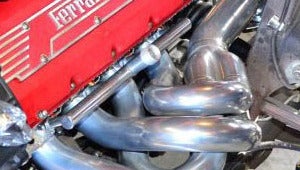
Gorgeous. I could hang these on my wall.
My girlfriend would hate it, but she lived with two wheels/tires as my coffee table for about a year without complaining too loud. I bet sheíd deal.
 they-will-know-my-velocity
> Chan - Mid-engine with cabin fever
they-will-know-my-velocity
> Chan - Mid-engine with cabin fever
12/03/2015 at 08:37 |
|
I think we need a video of the exhaust sound after this.
 yitznewton
> Chan - Mid-engine with cabin fever
yitznewton
> Chan - Mid-engine with cabin fever
12/03/2015 at 09:24 |
|
Worth a share to Jalopnik, thank you for writing this up!
 MonkeePuzzle
> Chan - Mid-engine with cabin fever
MonkeePuzzle
> Chan - Mid-engine with cabin fever
12/03/2015 at 09:43 |
|
inferior OEM parts.
so sad that ferrari parts were ever in inferior, at that price youíd expect them to know the right metal to use, and open fan motors are bad, etc.
also makes me wonder about the ďall originalĒ crowd, who would search high and low for what are known inferior parts to ensure authenticity
 Stephen T
> Chan - Mid-engine with cabin fever
Stephen T
> Chan - Mid-engine with cabin fever
12/03/2015 at 10:08 |
|
Thanks for the write-up. Itís great to read about the experiences of a true enthusiast who is willing share his/her knowledge.
The F355 is one of the cars that Iíve always had my heart set on owning one day with no illusions about what maintenance will be required. Have you had any issues with the paint at the point where the flying buttresses join the body? Iíve heard that itís something that all GTS/Berlinetta owners will have to deal with if you drive the car any distance at all ó what with the buttress rubbing against the painted body as it flexes. If so, is it something that can be mitigated or is an eventual re-spray something to be budgeted for by every F355 owner?
 RazoE
> Chan - Mid-engine with cabin fever
RazoE
> Chan - Mid-engine with cabin fever
12/03/2015 at 10:15 |
|
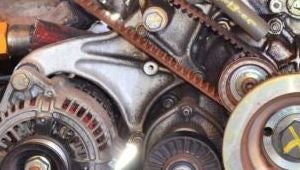
Turbo?!? I thought these were N/A.
 JasonH
> Chan - Mid-engine with cabin fever
JasonH
> Chan - Mid-engine with cabin fever
12/03/2015 at 10:36 |
|
Cheap steel on the headers is how Ferrari Fires are born?
 gin-san - shitpost specialist
> SnapUndersteer, Italian Spiderman
gin-san - shitpost specialist
> SnapUndersteer, Italian Spiderman
12/03/2015 at 10:53 |
|
I looked up this car expecting some sort of small, fun Japanese kei car but ended up with pretty much the opposite. Still, rather than saying, ďI drive a Caravan,Ē or ďI have an Odyssey,Ē itíd be much more fun to say, ďI have a Every Joy Pop... turbo.Ē
I think the only thing cooler than saying that would be, "I have a R63 AMG for the family."
 Chan - Mid-engine with cabin fever
> RazoE
Chan - Mid-engine with cabin fever
> RazoE
12/03/2015 at 10:57 |
|
Hey now. I was gonna get a tattoo of my Ferrari Turbo.
 SnapUndersteer, Italian Spiderman
> gin-san - shitpost specialist
SnapUndersteer, Italian Spiderman
> gin-san - shitpost specialist
12/03/2015 at 11:19 |
|
the R63 is definitely not cooler
 gin-san - shitpost specialist
> SnapUndersteer, Italian Spiderman
gin-san - shitpost specialist
> SnapUndersteer, Italian Spiderman
12/03/2015 at 11:24 |
|
Sorry, hadnít finished my morning coffee yet. In the past half-hour I had a chance to reflect on the error of my statement. After running through both sentences in my head I definitely prefer being able to say, "I have a Suzuki Every Joy Pop... turbo."
 SnapUndersteer, Italian Spiderman
> gin-san - shitpost specialist
SnapUndersteer, Italian Spiderman
> gin-san - shitpost specialist
12/03/2015 at 11:33 |
|
YYYYAAAAAAAAAAAAAAASSSSSSSSSSSSSSSSSSSSSSSSS :)
 Chan - Mid-engine with cabin fever
> SnapUndersteer, Italian Spiderman
Chan - Mid-engine with cabin fever
> SnapUndersteer, Italian Spiderman
12/03/2015 at 12:08 |
|
Ha! .............pic?
I always thought the Suzuki to brag about owning was the Justy, but itís not as cool a car aside from the name.
 Chan - Mid-engine with cabin fever
> Stephen T
Chan - Mid-engine with cabin fever
> Stephen T
12/03/2015 at 12:11 |
|
Excellent question. This is actually a point on which there is no real consensus. People who have experienced it on their Berlinetta or GTS will swear that it happens to every car. It necessitates repainting a large area of the car, but some people go one step further: Before the repaint, add tack welds to the two seams at about 1Ē intervals.
Yet others, including me, have had no problems whatsoever and the paint over the seams has no sign of trouble. Itís just something you will need to deal with if and when it happens.
You cannot pre-emptively add the tack welds because that would ruin the paint.
 Chan - Mid-engine with cabin fever
> yitznewton
Chan - Mid-engine with cabin fever
> yitznewton
12/03/2015 at 12:18 |
|
Sounds fun. How would I do that? Do I need to get posting privilege there, or contact one of the existing authors?
 Chan - Mid-engine with cabin fever
> MonkeePuzzle
Chan - Mid-engine with cabin fever
> MonkeePuzzle
12/03/2015 at 12:23 |
|
You need to tread carefully if you plan to enter your car in a Concours competition. Originality is king, and that Tubi exhaust and the Fabspeed headers will get you dinged.
Rebuilt OEM headers (from a vendor that uses T304 steel or better) are the right solution in that case, and you can go aftermarket on parts that arenít visible at an engine-in inspection. The judges wonít be able to catch your Hill Engineering belt bearings.
 Chan - Mid-engine with cabin fever
> they-will-know-my-velocity
Chan - Mid-engine with cabin fever
> they-will-know-my-velocity
12/03/2015 at 12:23 |
|
In addition, she will be jealous of its curves.
 MonkeePuzzle
> Chan - Mid-engine with cabin fever
MonkeePuzzle
> Chan - Mid-engine with cabin fever
12/03/2015 at 12:27 |
|
yeah, Iíve watched judging at concours type events, and itís just not an aspect of this car hobby I understand.
I think it was an episode of chasing classic cars where he was dinged for having the wrong knock off on the right wheels, but the knock off was an option from the factory. But, whatever.
In the truest of oppo spirits, a place where Ferrari F355 and PT Cruiser owners should be equally happy to share their love of cars, I shall attempt to not belittle the all original crowd, but simply state that itís something I donít understand.
 they-will-know-my-velocity
> Chan - Mid-engine with cabin fever
they-will-know-my-velocity
> Chan - Mid-engine with cabin fever
12/03/2015 at 12:29 |
|
Or at least the money I spent on it...
 yitznewton
> Chan - Mid-engine with cabin fever
yitznewton
> Chan - Mid-engine with cabin fever
12/03/2015 at 12:35 |
|
One of the Jalopnik editors would have to pull it in. I donít have any contacts there though...
 Chan - Mid-engine with cabin fever
> JasonH
Chan - Mid-engine with cabin fever
> JasonH
12/03/2015 at 12:36 |
|
In this case, not exactly.
For the F355, Ferrari Fires (TM) are born from a fuel filler neck joint in early cars that had degrading plastic. It would crack and leak fuel onto the LHS exhaust header, possibly igniting and beginning to burn other flammable parts in the area.
Out of an abundance of caution, many owners do not fill the tank to the maximum (the automatic cut-off), so there is no fuel in the filler neck to leak. Some theorise that the ethanol content in US gasoline is a factor.
Another, less common origin of F355 Ferrari Fires (TM) is incorrect reinstallation of the fuel distribution block during maintenance service. The braided steel fuel line would rub against surrounding structure and eventually pierce, causing a fuel leak. This actually forced Ferrari to redesign the fuel block and issue a recall. Every single F355 should have the updated fuel block (it looks visibly different as it routes the fuel lines differently), and if it doesnít, any dealer is required to perform the recall service at no charge.
 Chan - Mid-engine with cabin fever
> MonkeePuzzle
Chan - Mid-engine with cabin fever
> MonkeePuzzle
12/03/2015 at 12:42 |
|
Ferrari was not known for computerisation and R&D back in the 1980s, when the 348 (the base from which the F355 was evolved) was originally designed.
Itís just an imperfect world. Yes, the judges ought to understand that the parts are there because the original ones are The Suck. Oh well.
With the Tubi muffler, if youíre the type to go Concours with your car, you should probably have an original muffler on standby. The OEM exhaust tips are tinyólook up any photo from the original F355 press photo album.
Nearly every F355 has some form of aftermarket exhaust. Unlike the newer cars, it had a complicated bypass system which resulted in a very quiet and unimpressive idle. Tubi and Capristo are the most popular.
Chrysler should have updated the PT Cruiser. Such a practical car with an unfortunate reputation.
 Chan - Mid-engine with cabin fever
> CCC (formerly CyclistCarCoexist)
Chan - Mid-engine with cabin fever
> CCC (formerly CyclistCarCoexist)
12/03/2015 at 12:53 |
|
In the US, Fabspeed is the only game in town for aftermarket Ferrari exhaust headers. Several shops in the UK take return cores and rebuild the primary tubes (the usual point of failure) with T304 stainless steel.
Exhaust headers have been a failure point on the F430 as well, although for a different reason (insufficient flex causing joint/flange failure).
This and the sticky interior plastics are among the astounding things still afflicting modern-day Ferrari.
 Johnnyazz
> Chan - Mid-engine with cabin fever
Johnnyazz
> Chan - Mid-engine with cabin fever
12/03/2015 at 13:10 |
|
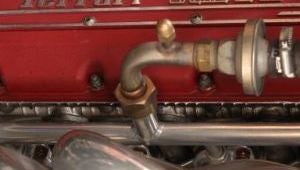
This is hard pornography
 StndIbnz, Drives a MSRT8
> Chan - Mid-engine with cabin fever
StndIbnz, Drives a MSRT8
> Chan - Mid-engine with cabin fever
12/03/2015 at 13:10 |
|
Keep them coming. This is very eye opening for a lot of us, especially me. Iíve always wanted a F355, no matter the horror stories. Its nice to see what all goes in to making these better cars and what to look for. They are just too damn pretty to not love, and that sound. Well done!
 Chan - Mid-engine with cabin fever
> StndIbnz, Drives a MSRT8
Chan - Mid-engine with cabin fever
> StndIbnz, Drives a MSRT8
12/03/2015 at 13:14 |
|
Thanks for the support. If you go in knowing exactly what to expect, it will no longer be a horror story. Although that fuse blowing up on the board nearly made me lose my @#$%.
Did you see my older post with the red and white Berlinettas next to each other?
 StndIbnz, Drives a MSRT8
> Chan - Mid-engine with cabin fever
StndIbnz, Drives a MSRT8
> Chan - Mid-engine with cabin fever
12/03/2015 at 13:26 |
|
I have not, Iíll have to go looking through your older stuff now though.
 SkyNet
> Chan - Mid-engine with cabin fever
SkyNet
> Chan - Mid-engine with cabin fever
12/03/2015 at 13:49 |
|
Please stop posting this stuff. You are making me think about buying my favorite Ferrari.
Which means I now have to choose between an F355 (which had previously left my stream of consciousness), and a 997 911, a used Miata, the occasional thought of a used NSX, the more than occasional thought of a used Espirit S4s.
(Disclaimer: Iíll probably end up not buying any of the above)
 Chan - Mid-engine with cabin fever
> 911e46z06
Chan - Mid-engine with cabin fever
> 911e46z06
12/03/2015 at 13:49 |
|
Donít envy me yet; my car hasnít appreciated to eleventy bajillion dollars like the air-cooled whale tails.
 RallyWrench
> Chan - Mid-engine with cabin fever
RallyWrench
> Chan - Mid-engine with cabin fever
12/03/2015 at 14:16 |
|
Thanks for the insight and detailed writeup. I primarily see German cars, but a client has a manual 355 so I may have it in the shop someday. Iíd heard about the header issue, but itís interesting to see the nature of the failure.
 mythrenegade
> Chan - Mid-engine with cabin fever
mythrenegade
> Chan - Mid-engine with cabin fever
12/03/2015 at 15:39 |
|
This is amazing.
I know it sounds ludicrous, but I can kinda see Ferrariís point on having to drop the engine for these kind of services. Once the engine is out of the car, everything is accessible and you can work on it. It also encourages you to go the extra mile to get everything nailed down rather than waiting for things to break.
Iím not saying Iím going to run out and buy an F355, but I really enjoyed this article. Thanks!
 Chan - Mid-engine with cabin fever
> mythrenegade
Chan - Mid-engine with cabin fever
> mythrenegade
12/03/2015 at 16:26 |
|
The 360 began Ferrariís transition away from engine-out service. Its belts are accessed from a panel that opens out from the cabin. The F430 moved to timing chains which only require inspection and lubrication.
Aside from the general hassle and access challenges to remove the rear subframe, engine-out service also stresses the electrical connectors. Every disconnection and re-connection loosens electrical pins, and this is especially true of old connectors that have become brittle. Some F355 owners have moved to a brand new gold connector kit designed by an American company (Scuderia Rampante Innovations) with startling improvements. Once again, itís pricey ($2k+).
 Chan - Mid-engine with cabin fever
> Johnnyazz
Chan - Mid-engine with cabin fever
> Johnnyazz
12/03/2015 at 22:00 |
|
I guess different countries have different names for an exhaust header.
 Chan - Mid-engine with cabin fever
> SkyNet
Chan - Mid-engine with cabin fever
> SkyNet
12/03/2015 at 22:01 |
|
Esprit, think of all those man points! The F355 comes close.
 Chan - Mid-engine with cabin fever
> SkyNet
Chan - Mid-engine with cabin fever
> SkyNet
12/03/2015 at 22:56 |
|
From an older post. You sure you donít want one?
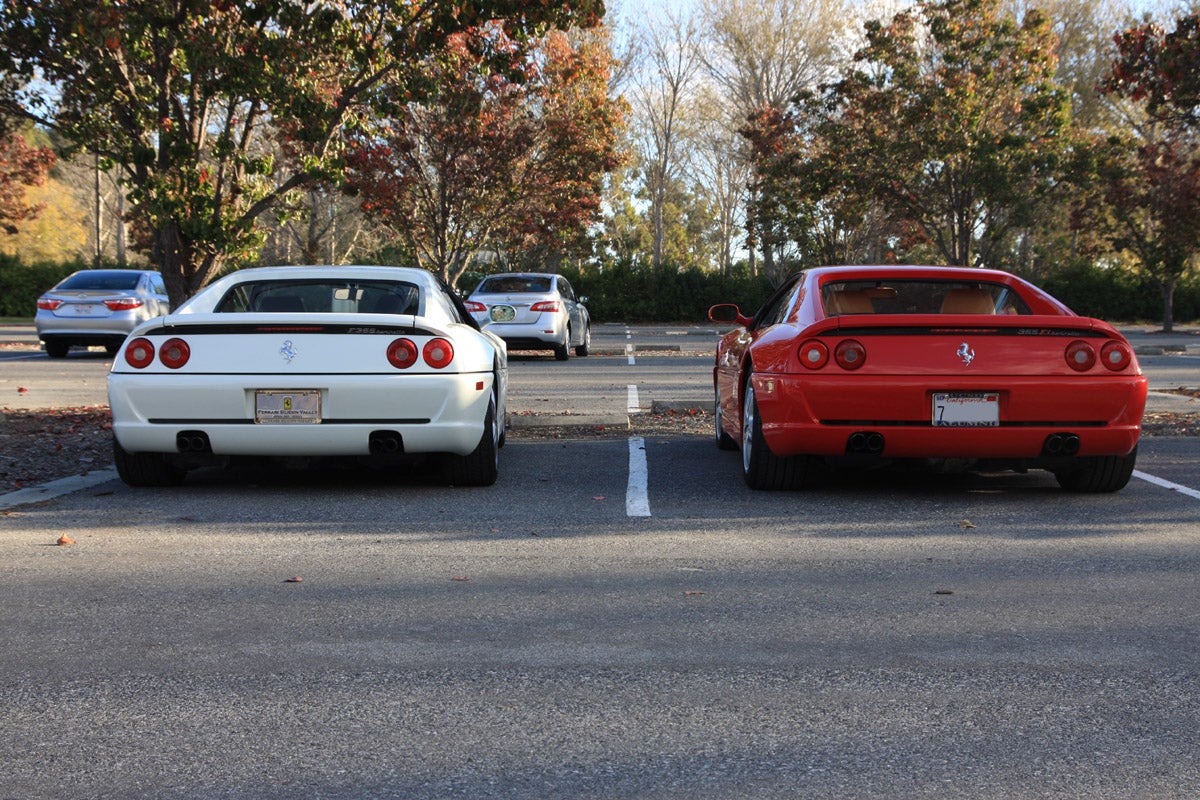
 Chan - Mid-engine with cabin fever
> they-will-know-my-velocity
Chan - Mid-engine with cabin fever
> they-will-know-my-velocity
12/04/2015 at 02:40 |
|
It sounds exactly like this Spider that DtRockstar1 recorded a while back. Same Tubi exhaust.
 SkyNet
> Chan - Mid-engine with cabin fever
SkyNet
> Chan - Mid-engine with cabin fever
12/04/2015 at 09:08 |
|
The Espirit is the first car I ever loved.
If by man points, you mean ďtime and money spent constantly fixing the car and being afraid to drive it out of fear of the next major problemĒ I completely agree.
I also spend too much time thinking about how fun it would be to own an Rx-8 as well haha.
 SkyNet
> Chan - Mid-engine with cabin fever
SkyNet
> Chan - Mid-engine with cabin fever
12/04/2015 at 09:09 |
|
I definitely do want one...
 Chan - Mid-engine with cabin fever
> RallyWrench
Chan - Mid-engine with cabin fever
> RallyWrench
12/04/2015 at 13:57 |
|
Owning the car really dispels the mythical reputation that embedded itself in my childhood brain. Itís just a very unique assembly of metal, plastic, leather and lubricants. Some of the parts are Epic Fails, but you canít fault the main engine assembly. The block, crankcase and pistons are supposedly bulletproof as long as you get rid of all of the surrounding problems.
Trying to drive a car with failed headers/cats can lead to bent valves and scored cylinder liners. I cannot express how reluctant I was to start the thing and drive it from the tow truck onto the service bay lift.
 Chan - Mid-engine with cabin fever
> SkyNet
Chan - Mid-engine with cabin fever
> SkyNet
12/04/2015 at 14:37 |
|
Get an Esprit V8. Then you wonít need the F355, because it sounds like a Ferrari V8 with the flat-plane crank and what I suspect is the same firing order.
You can always get an RX-8 later. They made lots of those.
 SkyNet
> Chan - Mid-engine with cabin fever
SkyNet
> Chan - Mid-engine with cabin fever
12/04/2015 at 14:57 |
|
And the rest of the list? haha
Iíd love an Espirit v8 but I really want and S4s.
For a variety of reasons (most of which are wife related) the car may have to be a daily driver if I want to get anything within the next year. Otherwise I maybe be able to swing a ď3rd carĒ in about two years.
Which means that realistically, to get the all important wife sign off I need a backseat.
Of course, every once in a while I think I can convince her to let me get a 2 seater...and a 3rd car instead of a daily...

 Chan - Mid-engine with cabin fever
> 450X_FTW
Chan - Mid-engine with cabin fever
> 450X_FTW
12/05/2015 at 00:42 |
|
I nearly went ape@#$% when I saw that. My other problems were all well-dissected issues with known solutions, but a damaged fuse board on an F355 would be very, very bad news. The design is bad enough already as it is. High-current-draw circuits are not sufficiently isolated from low-power electronics, etc.
 Chan - Mid-engine with cabin fever
> they-will-know-my-velocity
Chan - Mid-engine with cabin fever
> they-will-know-my-velocity
12/05/2015 at 22:54 |
|
Uploaded a tunnel vid; check out my post from last night.
 they-will-know-my-velocity
> Chan - Mid-engine with cabin fever
they-will-know-my-velocity
> Chan - Mid-engine with cabin fever
12/05/2015 at 23:38 |
|
Unf
 noselunting
> SkyNet
noselunting
> SkyNet
01/23/2016 at 19:34 |
|
Youíll be pleased to note that as of the Series 1 Elise, Lotus moved on from that. Now itís a case of time and money spent constantly fixing the car only to drive it and hear a new and undoubtedly more expensive sounding noise emanating from somewhere deep inside the car. From the owners point of view the game you play how many of those noises you can hear before something genuinely big and expensive lets go. My personal best over a 5 year ownership period is 9 months between off the road expensiveness sessions.
Oh how we suffer for our art.
 05011994
> Chan - Mid-engine with cabin fever
05011994
> Chan - Mid-engine with cabin fever
01/24/2016 at 23:31 |
|
Tubi are the gold standard for replacement headers as they are the only ones to keep the 4-2-1 configuration and have the proper heat shielding. Another benefit is that they do not lower the tone of the sound because the configuration is the same. Finally there is no question as to the country of origin as there is with other replacement headers for the 355. I got my Tubistyle headers from Champion Motorsport which is the official Tubistyle importer for North America. I have not had an issue with the headers since they were installed in 2007.
 05011994
> Chan - Mid-engine with cabin fever
05011994
> Chan - Mid-engine with cabin fever
01/24/2016 at 23:38 |
|
Scuderia Rampante installed the gold kit on my 355 during my last major service in 2013 and it transformed the car along with Dave Helms cam timing. It is well worth the money.
 Chan - Mid-engine with cabin fever
> 05011994
Chan - Mid-engine with cabin fever
> 05011994
01/25/2016 at 01:43 |
|
Good to hear your Tubi headers have been trouble-free.
I went with Fabspeed due to their friendlier price and strong reputation for customer service. I am also well aware of the origin of the parts and the batch per-unit cost of manufacture.
After installing them, I couldnít really tell the difference from my old OEM headers even with the different 4-1 design. Because they are open without an external heat shield, ceramic coating is strongly recommended. Mine are coated on both sides.
 Straightsix9904
> Chan - Mid-engine with cabin fever
Straightsix9904
> Chan - Mid-engine with cabin fever
01/25/2016 at 17:48 |
|
Hey, I just found this post. I read the Interior one a few days ago. This was a great read.
Are you afraid to really get on the car for fear of breaking something. I would just be terrified. Of course, I canít write $5,000 checks for headers either. I know you really should get on the right pedal to keep carbon off the valves, but it would just be nerve racking.
 Chan - Mid-engine with cabin fever
> Straightsix9904
Chan - Mid-engine with cabin fever
> Straightsix9904
01/25/2016 at 18:14 |
|
The engine loves to breathe. Let the fluids warm up, then run it up at least for 2 or 3 gears, conditions permitting. I donít hit redline too often but I regularly get it up to a healthy 7k RPM. Give it a few miles to cool down when bringing it home. Thatís all there is to it.
Cruise at 3500 rpm on a Toyota and you get the sense that it just wants to loaf along. It sounds thrashy and strained. ďAlright Iíll do it, but I really would rather be at 2200.Ē
Cruise at 3500 rpm on this thing and it keeps daring you to just go. Itís buttery-smooth and without looking at the tach I would swear itís at 1500 rpm. ďWake up, letís go. Youíre holding me back.Ē
If something breaks, itís not because you drove the car the right way.
 Straightsix9904
> Chan - Mid-engine with cabin fever
Straightsix9904
> Chan - Mid-engine with cabin fever
01/25/2016 at 18:45 |
|
ďIf something breaks, itís not because you drove the car the right wayĒ
Now that is the way to look at it!
 Drakkon- Most Glorious and Upright Person of Genius
> Chan - Mid-engine with cabin fever
Drakkon- Most Glorious and Upright Person of Genius
> Chan - Mid-engine with cabin fever
01/29/2016 at 09:45 |
|
Next time you need a service, put a Ford Voodoo in there and you can have v-8 power without the puh-patta-puh-patta of an LS
 Chan - Mid-engine with cabin fever
> Drakkon- Most Glorious and Upright Person of Genius
Chan - Mid-engine with cabin fever
> Drakkon- Most Glorious and Upright Person of Genius
01/29/2016 at 14:29 |
|
But does it rip to 8000+ RPM like two Honda Type-Rs joined at the crank?
 Drakkon- Most Glorious and Upright Person of Genius
> Chan - Mid-engine with cabin fever
Drakkon- Most Glorious and Upright Person of Genius
> Chan - Mid-engine with cabin fever
01/29/2016 at 14:47 |
|
It does rip to 7500 of flat-plane goodness. Letís throw a lighter flywheel in there, too!!
Pretty sure some tinny mufflers and a smaller flywheel and this would zing rather than roar.
 Chan - Mid-engine with cabin fever
> Drakkon- Most Glorious and Upright Person of Genius
Chan - Mid-engine with cabin fever
> Drakkon- Most Glorious and Upright Person of Genius
01/29/2016 at 15:14 |
|
There are several critical design differences between Fordís and Ferrariís engines that guarantee the GT350 will sound different:
1. Crank configuration / Firing order
Ford: v ^ v ^ (imagine four V-twins joined at the crank)
Ferrari: v ^ ^ v (imagine two inline-fours joined at the crank)
2. Exhaust headers
Ford: Unequal-length (required by crankshaft configuration)
Ferrari: Equal-length
3. To a more limited extent, the intake also contributes.
Ford: Single manifold for all 8 cylinders
Ferrari: Dual manifolds, one for each bank
A GT350 will sound like four Ducatis.
A Ferrari 458 will sound like two Integra Type Rs.
 Xanzar123
> Chan - Mid-engine with cabin fever
Xanzar123
> Chan - Mid-engine with cabin fever
02/08/2016 at 18:38 |
|
Thatís right, the MR2 actually stayed in working condition from the factory, there is nothing quite like an MR2 when reliability is a concern. Save for a Honda.
 Sustain26
> Chan - Mid-engine with cabin fever
Sustain26
> Chan - Mid-engine with cabin fever
06/25/2017 at 17:58 |
|
Chan,
No way of contacting you offline? Iím looking for a complete list of parts that you replaced along with costs involved. In my area (Quebec, Canada), there is a mechanic but heís only quoting a major service without having seen this VGA Ď98 f355 spider. Before I see it, I would need to know what to look for visually.
Any help appreciated - mogiljan_2 at yahoo dot ca .
 Chan - Mid-engine with cabin fever
> Sustain26
Chan - Mid-engine with cabin fever
> Sustain26
06/25/2017 at 18:46 |
|
I can post a list later, but what is VGA?
The thing with a major service is there are things that you donít find out until you tear off the intake, the headers, etc. Some things you wonít even see until the engine is out.
 Sustain26
> Chan - Mid-engine with cabin fever
Sustain26
> Chan - Mid-engine with cabin fever
06/25/2017 at 20:45 |
|
VGA = Vťhicule Gravement Accidentť.
But CarProof doesnít say what was fixed or what it cost. If I get a test drive, I might notice something isnít right? If thereís no frame damage, Iím guessing a major service is the bare minimum thatís required. But your article gives me something to work with that I havenít seen before. In fact, I was giving up.
 Chan - Mid-engine with cabin fever
> Sustain26
Chan - Mid-engine with cabin fever
> Sustain26
06/26/2017 at 00:17 |
|
If youíre set on buying an accident car, you need a thorough inspection by a trusted technician to see what was damaged and how it was fixed. Unfortunately I have no advice for you on that aspect as I lack that experience. Exotic cars are VERY difficult to repair correctly.
 Chan - Mid-engine with cabin fever
> Sustain26
Chan - Mid-engine with cabin fever
> Sustain26
06/26/2017 at 02:03 |
|
Looking at my spreadsheets, it seems that I did list pretty much everything that was replaced at the major service. The above is a fair example of the typical major service items plus a few ďdiscoveries.Ē
What makes it simpler for an exotic car is that there arenít that many vendors. Start with the major service kit from Ricambi America.
The other parts should be shopped between Ricambi and stores like RockAuto (they have a lot of the sensor-type parts), Amazon (fluids), AW Italian. Ricambi is most likely to have the OEM part you need, especially for Ferrari-specific parts like engine mounts. But sometimes other places have better prices for common parts.
Spark plug wires from Kingsborne.
Radiator fans from SPAL USA or The-Fan-Man.
For any technical debate between which exact part to use, the issue has probably already been discussed on FerrariChat.
When you have your car in for its major service, just follow up with me here and I can provide you with my advice on specific issues/parts.
 Sustain26
> Chan - Mid-engine with cabin fever
Sustain26
> Chan - Mid-engine with cabin fever
06/26/2017 at 08:36 |
|
Thanks!
 Sustain26
> Chan - Mid-engine with cabin fever
Sustain26
> Chan - Mid-engine with cabin fever
06/26/2017 at 09:11 |
|
The f355 spider was originally a US car, but the only car registered still with the NHTSA (because of a recall never accomplished) has one digit different in the VIN shown at the dealer; the plot thickens.
 EJF2461
> Chan - Mid-engine with cabin fever
EJF2461
> Chan - Mid-engine with cabin fever
07/03/2017 at 21:20 |
|
Really nice post! I recently bought a 97' 355 Spider 6 speed gated manual. 26k. I am planning on a engine out service when it gets cold outside here in Indianapolis. Do you have a certain place you prefer parts from? We have no Ferrari Dealer in Indianapolis and only 1 mechanic I know of local. Do you recommend doing the clutch (Stick Shift Cars) while getting the service? What about the F/R suspension at the same time. I have had my car less than a week and it seems to drive decent minus an airbag light and I cant get the top to go down! Grrrr! I also broke the passenger side latch while trying to put the top back up. Since I donít have access to regular Ferrari pros I wanna do as much as possible when I do service. Any body you can recommend with in 500 miles of me for a complete service? Any advise on the Convertible top before I take my chainsaw to it?
 Chan - Mid-engine with cabin fever
> EJF2461
Chan - Mid-engine with cabin fever
> EJF2461
07/04/2017 at 02:23 |
|
I buy most parts from Ricambi America. I donít have any recommendation for mechanics or when to do suspension work, but a common worry-free solution for the top is to leave it down all the time ;P
Some people also source 348 Spider parts and convert their F355 Spiders to a manual top.
The clutch does not need to be done with the engine-out service, but only you can be the judge of how worn the clutch feels. Access is easier than the 360 and F430 clutches since the bell housing sits way out back.
Enjoy your Spider and let all of the maintenance adventures just be part of the experience!
 Jules
> Chan - Mid-engine with cabin fever
Jules
> Chan - Mid-engine with cabin fever
10/28/2017 at 09:27 |
|
Great article, Iím actually going to copy this for my own benefit for future reference when ďThat TimeĒ comes.
 CharlesUK
> Chan - Mid-engine with cabin fever
CharlesUK
> Chan - Mid-engine with cabin fever
12/26/2017 at 13:13 |
|
Hi, very interesting read. I bought my Ď97 F355 UK variant 6 years ago and have luckily had very little trouble. I only use it in the summer and never in the rain.
Unfortunately the car went in to limp/safe mode. I found that 1 of the Cat sensors was faulty so I replaced it, and the car then ran fine for the last 4 years. I got stuck in traffic for over an hour and the car went in to safe mode, on this occasion I changed the Cat sensors on both sides, but need to get the car out of safe mode. Is there any way I can do this without taking it to a Ferrari dealer, which a long drive away? I have carried out checks and found that the 8 spark plus are firing ok and all pistons are firing, so the safe mode must regulate the fuel. Am I right in believing this? My model used the Bosch 168600 Motronic 5.2 ECU. Are these readily available?
 Chan - Mid-engine with cabin fever
> CharlesUK
Chan - Mid-engine with cabin fever
> CharlesUK
12/26/2017 at 13:19 |
|
In my experience, if the car sits too long in traffic the cats can overheat. For me this was about 20-30 mins just idling as a chatty colleague distracted me from turning the car off.
Unfortunately I suspect that the code needs to be cleared. Not sure if itís a standard OBD2 code or a proprietary Ferrari SD2 code, but try searching online to see if you can clear it with a normal OBD2 reader (not sure if EU used the same standards as the US in the late 90s). Is it the ďSlow DownĒ light?